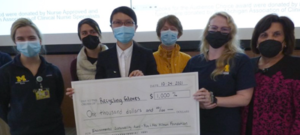Alzheimer’s disease remains a pressing public health concern, ranking as the fifth leading cause of…
by Dr. Jessica Marsack (UMICH ’18) | December 10, 2021
As Hillman Scholars in Nursing Innovation alumni, Dr. Megan Czerwinski (UMICH ’20) and I were originally interested in hosting a more targeted event focused on a hackathon to improve the environmental sustainability of products and skills used in nursing skills simulation. Together with colleagues at the University of Michigan School of Nursing Clinical Learning Center (CLC), we were troubled by the hundreds of pounds of plastic supply waste generated each term. We hoped our hackathon could generate ideas for solutions to decrease plastic waste in the CLC. We also recognized that the low stakes setting of the CLC was a great place to pilot and refine waste reduction ideas that may help tackle the larger issue of healthcare waste (over 5 billion tons generated per year!)
However, as with so many things, the pandemic altered our plans. In this case, the postponing of our hackathon provided an opportunity to collaborate with the University of Michigan Healthcare Innovation Impact Program (HiiP), which was planning their own student-led hackathon. This alliance turned our idea into a much broader and interdisciplinary event, named the Innovate 4 Change hackathon. The event was led by seven undergraduate and graduate student innovation ambassadors and coordinated by Dr. Michelle Munro-Kramer and Ann Fitzsimons of the School of Nursing.
Teams could form and innovate in any of the five general topic areas:
- Environmental Sustainability
- Health Equity
- Psychological & Physical Safety of Nurses
- Global Health
- Open Topic
Dr. Czerwinski and I served as the coaches for the Environmental Sustainability area of focus. We were able to incorporate elements of our original plans, especially at the kick-off event, where we brought in common supplies from the CLC – including syringes, a catheter kit, IV tubing, an incentive spirometer, etc. – for students to tinker with while inviting them to consider the issue of healthcare waste.
Over the course of five weeks, seven teams worked together to identify problems, brainstorm solutions, research alternatives, and eventually develop an innovative idea. Student teams pitched their ideas on October 24th to a panel of five judges and a virtual and in-person audience of peers, donors, and supporters. The teams represented all levels of undergraduate and graduate students with participants from nursing, engineering, public health, dentistry, information science, data science, health informatics, and business. Each team had 5-7 minutes to present a compelling case for their ideas that covered topics such as vaccine verification, supporting new mothers, addressing postpartum hemorrhage, recycling healthcare waste, safer ways to transport patients, and transportation for the elderly.

Building on the original idea, environmental sustainability became one of the topical areas for students to self-select and focus on. The team we mentored, recycling healthcare waste, came up with an idea for a university-wide glove recycling program based on what Gefei Wang, a dental student on the team, had seen in her school’s simulation lab. The students on the team all recognized that while gloves in the hospital are difficult to recycle due to infection concerns, simulation centers are lower-stakes environments without the risk of bodily fluid contamination. The team was ultimately selected by a panel of expert judges in innovation and entrepreneurship as one of the winners. The prize money provided by the Hillman foundation is allowing the team to move forward with the idea to partner with simulation labs across the university to institute a glove recycling program supported by the Kimberly-Clark company. We believe this broad, interdisciplinary intervention is a direct outcome of the event design. The student-led nature of this event contributed to the focus on increasing environmentally sustainable actions in learning environments, which do not have the same infection concern barriers as clinical environments. In addition, the students had greater buy-in and commitment to the project because they were able to take ownership of their work. Similarly, the interdisciplinary nature of the event pushed the team to think beyond the School of Nursing and broaden the idea to a campus-wide initiative. These efforts are currently ongoing, and we look forward to seeing what our student team can accomplish!